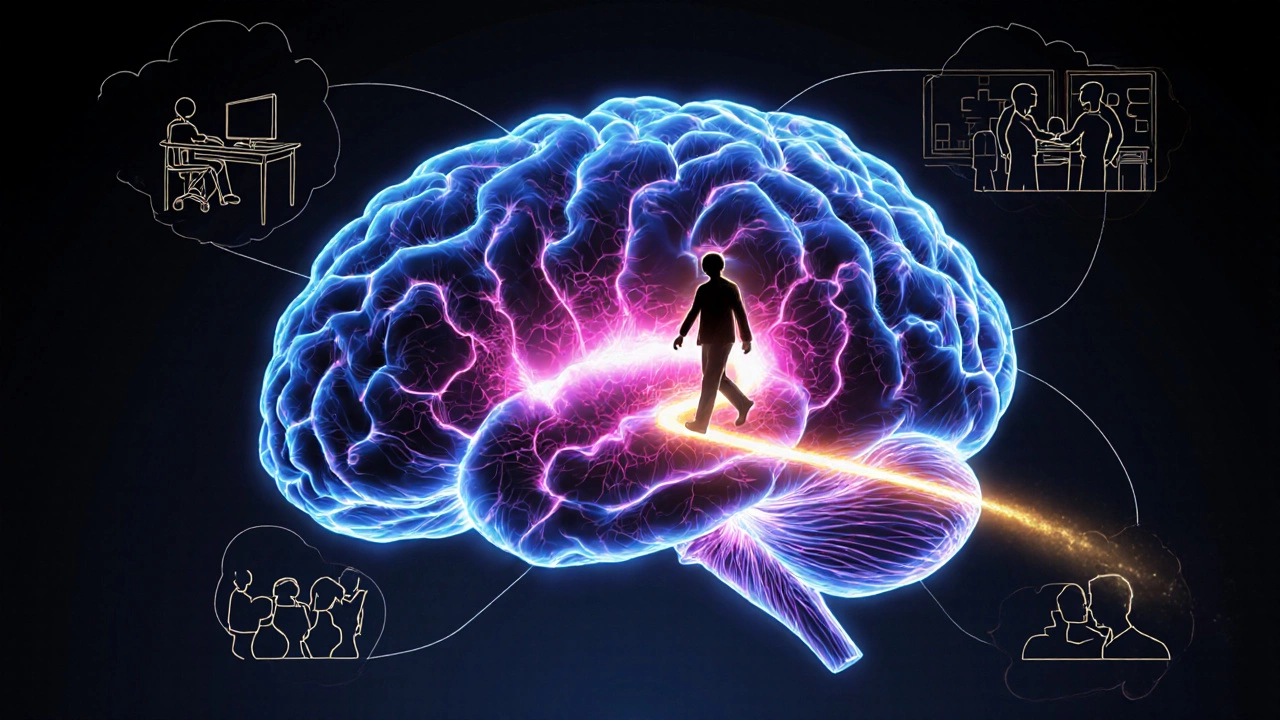Mindfulness Impact Calculator
How Long Before You See Results?
Based on research from Harvard, UC Irvine, and other institutions, we've created this tool to estimate your potential benefits from mindfulness practice. Note: Individual results may vary.
Key Takeaways
- Mindfulness can lower the body's stress hormone, cortisol, leading to calmer days.
- Regular practice sharpens attention and improves focus at work or school.
- Being present boosts emotional regulation, helping you handle anxiety and relationships better.
Ever wonder why so many people rave about meditation apps and quiet‑time breaks? The answer lies in three core areas where mindfulness benefits show up most clearly: stress, focus, and emotional balance. Below we’ll unpack each one, back it up with real research, and give you practical steps to feel the change yourself.
What Mindfulness Actually Is
When you hear the word Mindfulness is the practice of paying attention to the present moment without judgment, you might picture a monk sitting on a cushion. In reality, it’s any activity where you deliberately notice thoughts, feelings, and sensations as they arise, then let them pass.
Scientists call it a mental muscle. Like any muscle, the more often you use it, the stronger it gets. Below we’ll see how that strength translates into three tangible improvements.
1. Cutting Stress: The Cortisol Connection
Stress isn’t just a feeling; it’s a chemical response. When you’re under pressure, your adrenal glands release Cortisol is a hormone that prepares the body for a "fight‑or‑flight" reaction. High cortisol over weeks or months can raise blood pressure, disturb sleep, and even shrink the hippocampus, the brain area that handles memory.
Research from Harvard Medical School in 2023 showed that participants who completed an eight‑week mindfulness‑based stress reduction (MBSR) program lowered their cortisol by an average of 20% compared to a control group. The shift wasn’t just lab data; people reported feeling calmer during meetings, sleeping through the night, and snacking less on comfort food.
How does mindfulness do this? By training the brain to notice stress signals early-like a racing heart or a rapid breath-so you can intervene before the cascade of cortisol takes over. Simple breathing exercises, body scans, or even a two‑minute pause before answering an email can interrupt that stress loop.
2. Sharpening Attention and Focus
In a world of constant notifications, attention feels like a short‑lived resource. The mental skill most directly tied to focus is Attention is the ability to selectively concentrate on specific information while ignoring distractions. Studies using the Stroop test-a classic measure of selective attention-found that just ten minutes of mindful breathing improved scores by 15%.
A 2022 University of California, Irvine study tracked college students over a semester. Those who practiced mindfulness for 15 minutes a day showed a 30% increase in sustained attention during lectures and scored higher on exams that required deep reading.
Practical tip: try the "5‑4‑3‑2‑1" grounding technique. Look around and name 5 things you see, 4 you can touch, 3 you hear, 2 you smell, and 1 you taste. This short exercise pulls attention back into the present, training the brain to stay on task longer.

3. Boosting Emotional Regulation and Well‑Being
Emotions are rapid, but our reactions to them can be slower and often unhelpful. Emotional regulation is the process of influencing which emotions we have, when we have them, and how we express them is a cornerstone of mental health. Mindfulness creates a pause between feeling and reacting, allowing you to choose a healthier response.
Neuroscience backs this up: a 2024 scan of seasoned meditators revealed increased activity in the prefrontal cortex- the brain’s decision‑making hub- and decreased activity in the amygdala, the fear‑center. In plain terms, mindfulness makes you calmer and more thoughtful.
What does that look like day‑to‑day? Less snapping at a coworker, fewer binge‑eating episodes, and a steadier mood during stressful projects. People with generalized anxiety disorder who added an eight‑week mindfulness program to their treatment saw anxiety scores drop by 40% compared to medication‑only groups.
How Mindfulness Fuels Neuroplasticity
All three benefits tie back to Neuroplasticity is the brain's ability to reorganize itself by forming new neural connections throughout life. By repeatedly practicing present‑moment awareness, you literally reshape brain pathways linked to stress response, attention, and emotion. This rewiring is why benefits grow stronger with consistent practice.
Real‑World Applications: From the Office to the Classroom
Businesses have taken note. A 2023 survey of Fortune 500 companies reported that 68% offered mindfulness programs, citing a 12% rise in Workplace productivity is the overall efficiency and output of employees in a professional setting after six months of guided sessions.
Teachers are also using brief mindfulness breaks to help students manage test anxiety. In a pilot at a Wellington primary school, pupils who practiced a 5‑minute mindful breathing routine before math tests improved scores by an average of 8%.
Quick Start Guide: 3 Simple Practices to Try Today
- Breathing Awareness (2‑5 minutes): Sit comfortably, close your eyes, and focus on the rise and fall of each breath. When thoughts drift, gently label them "thinking" and return to the breath.
- Body Scan (5‑10 minutes): Starting at your toes, notice sensations moving upward. Acknowledge tension without trying to change it, then let it release as you continue.
- Mindful Walking (5‑15 minutes): Walk slowly, feeling each footstep, the sway of your arms, the air on your skin. Use the rhythm of your steps as a natural anchor for attention.
Do one of these daily for two weeks and note any change in stress levels, focus, or mood. Most people feel a shift within the first few sessions.

Comparison: Before vs. After a Consistent Mindfulness Routine
| Indicator | Before Practice | After 8‑Week Practice |
|---|---|---|
| Cortisol (stress hormone) level | Average 18 µg/dL | Average 14 µg/dL (‑22%) |
| Attention span (minutes) | 12 | 18 (+50%) |
| Self‑reported anxiety (scale 1‑10) | 7 | 4 (‑43%) |
| Workplace productivity (tasks/hour) | 6 | 8 (+33%) |
Common Pitfalls and How to Avoid Them
- Thinking you must empty the mind. The goal is awareness, not emptiness. Notice thoughts without getting tangled.
- Skipping consistency. Benefits compound. Even a minute a day beats a three‑hour session once a month.
- Being hard on yourself. If you lose focus, gently bring it back. Self‑criticism defeats the purpose.
Beyond the Basics: Advanced Practices
If you’ve mastered the three starter techniques, consider adding these:
- Open‑monitoring meditation: Instead of focusing on a single object, let attention flow freely, noting whatever arises.
- Loving‑kindness (metta): Silently repeat phrases like "May I be happy, may you be safe" to boost compassion.
- Mindful journaling: Write down sensations and emotions after each session to track progress.
Frequently Asked Questions
How long does it take to notice benefits?
Most people report a calmer mind and clearer focus after 2‑3 weeks of daily practice. Measurable changes in cortisol or attention span typically appear after 6‑8 weeks.
Do I need special equipment?
No. A quiet spot, a comfortable seat, and maybe a timer are enough. Many apps offer guided sessions if you prefer a voice.
Can mindfulness help with chronic pain?
Yes. Studies show that mindfulness‑based stress reduction can lower pain intensity by 30% and improve quality of life for chronic pain sufferers.
Is mindfulness the same as meditation?
Meditation is a formal practice that often uses mindfulness techniques, but mindfulness can also be applied informally to any daily activity.
What’s the best time of day to practice?
Morning sessions set a calm tone for the day, while evening practice can help unwind. Pick a time you can stick to consistently.
Mindfulness isn’t a magic cure, but it’s a reliable tool you can start using right now. By lowering stress, sharpening focus, and stabilising emotions, you’ll likely notice better performance at work, stronger relationships, and a healthier body. Give the three simple practices a try-your future self will thank you.







